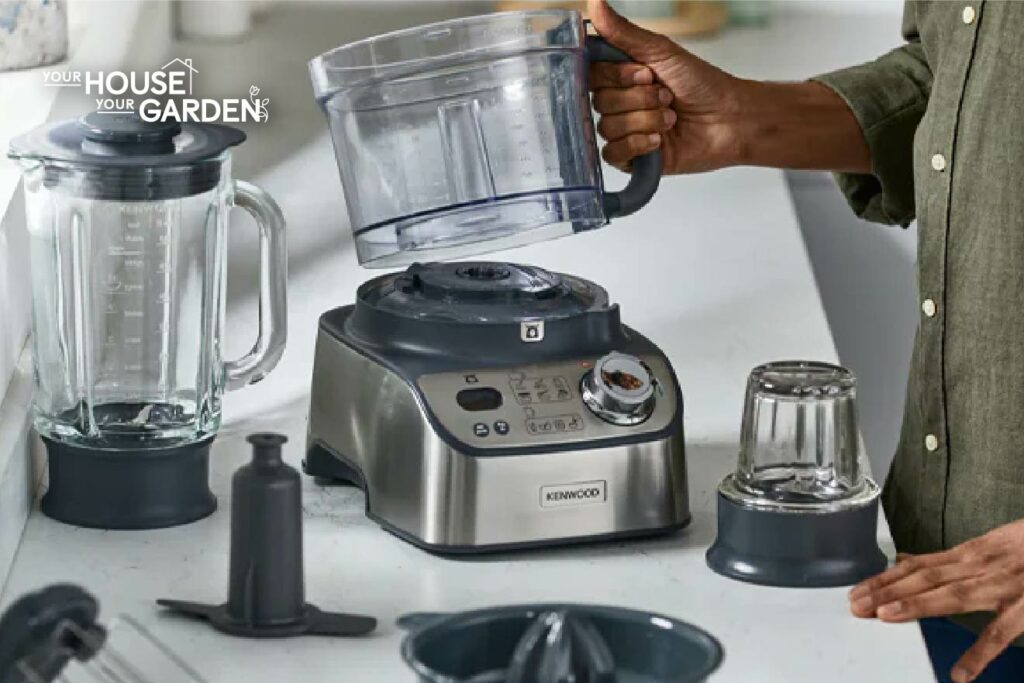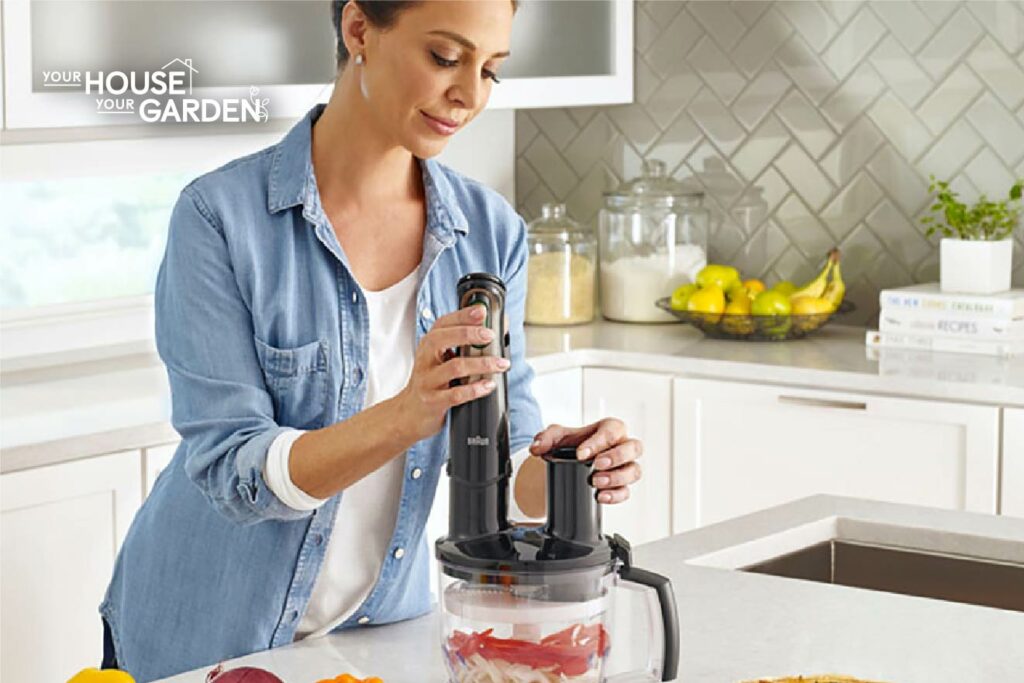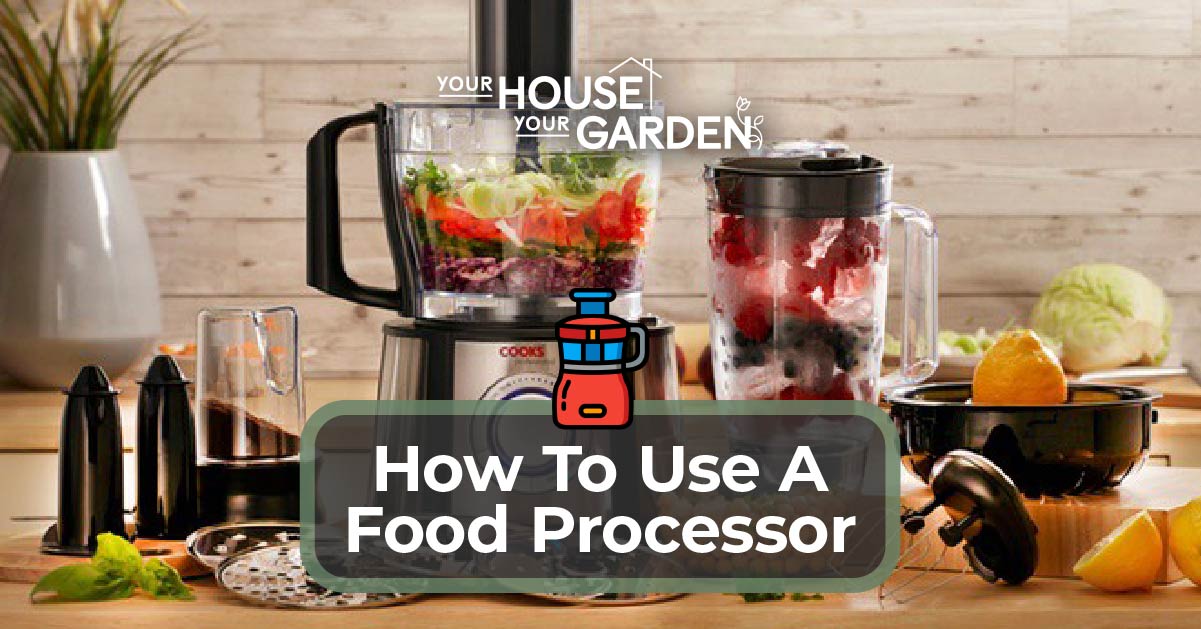Using a food processor involves the following steps: assembling the appliance, attaching the appropriate blade, filling the bowl with the food you wish to process, closing the lid, and pressing start.
What is a food processor? A food processor is a small kitchen appliance used to chop, mix, puree, emulsify, and shred food. The appliance comes with several different blades and can even be used to knead dough.
To learn more about how to work a food processor, refer to our in depth food processor usage guide below.
1. Assemble The Food Processor
Before you can use the food processor, it must be assembled. While every make/model is slightly different, the process starts by securing the plastic bowl to the base. From there, install the blade, the blade tube, and the lid.
Always make sure the food processor is turned off and unplugged during the assembly process. Moreover, make sure each item is securely locked in place before moving on to the next one.
2. Choose Your Blade
Although this stage is part of the assembly process, it’s worth looking into in detail due to the number of different blades available. While some processors come with 12+ blades, there are a handful of blade types that are common among all make/models, the most important being:
- S-Blade: The S-Blade is the most common blade and can be used for a variety of purposes. One important aspect of the S-Blade is that it can be used to process both dry and wet foods. To give you an idea of its large range of functions, the S-Blade can be used to puree fruits, knead bread, and grind meat. If you’re ever in doubt about which blade to use, the S-Blade is a good fall back option.
- Juliana Blade: A good choice for dicing vegetables like tomatoes, celery, and more. Can also be used to cut fruit into fine strips.
- Slicing Blade: Used to cut fruits and vegetables into slices. Most slicing blades give you the option of different thicknesses, meaning you can cut fruits/vegetables into thin, medium, or thick strips.
- Dicing Blade: Another type of blade designed to dice fruits and vegetables. A good option for cucumbers, celery, tomatoes, onions, apples, and more.
- Whipping Blade: Used for whipping eggs or heavy cream.
- Grating Blade: One of the most popular options, the Grating Blade is designed for grating medium to hard cheeses like Cheddar, Parmesan, Apple Wood, and more.
- Dough Blade: Usually made out of plastic, the dough blade is designed specifically for kneading dough and nothing more.
- Perforated Blade: The best option for shredding tough vegetables like potatoes, carrots, beets, ginger, and more.
When you’ve chosen the correct blade, make sure it’s firmly secured in place. If it’s not, it can come loose during when turned on and cause damage.
3. Load Ingredients Into Food Processor Bowl
Once you’ve chosen and installed the appropriate blade, it’s time to load the food processor bowl with the ingredients you wish to process. When doing so, be careful to not overload the bowl, as doing so can cause strain on the motor and may even cause the machine to stall out.
If you’re processing large vegetables, like carrots, cucumbers, or beets, cut them into smaller chunks before loading them into the food processor. Not only will this allow you to better maximize space, but it’ll also reduce the strain on your food processor.
4. Choose Setting and Press Start
Which setting you use will depend on which blade you’re using and what presets your food processor comes with. For example, if you’re pureeing fruits, choose the puree setting. If you’re whipping eggs, choose the whip setting.
If you’re processing a mix of fruits and vegetables, start by pressing down on the ‘Pulse’ button for a second or two. Doing this will let you know if the blade you’ve chosen can handle the ingredients you’re attempting to process. If you press the pulse button and see the blade is having a hard time chopping through the ingredients, you may require a different blade.
Some Food processors don’t come with several different presets and just a Start/Pulse button. If your processor falls into this camp, just make sure you’ve chosen the right blade for the task.
5. Empty Out Contents
Once your ingredients have been fully processed, turn the food processor off, unplug it from the wall, remove the lid, and empty its contents into an appropriate bowl or container. Depending on what food you’ve processed, you may need to scrape the sides of the bowl with a spoon or spatula.
6. Wash Components
It’s a good idea to wash the food processor components right away before the food has time to harden. If you don’t, it can make the blade and bowl difficult to clean. At the very least, take a moment to rinse the bowl, blade, and other parts.
If you plan on placing the food processor parts in the dishwasher, there are two things to keep in mind. First off, make sure the item in question is dishwasher safe. Secondly, like any knife, a food processor blade will dull over time.
Because of this, it’s good practice to place processor blades on the top rack of the dishwasher, not the bottom. When placed on the bottom, they are in contact with scalding hot water, which can wear down the blade over time.

Food Processing Usage Tips for Food Process and Better Processing
When using a food processor, there are several tip and tricks you can follow to improve efficiency, including:
Insert Blade First: Some people believe it’s easier to load the ingredients into the processor basket before the blade. While this may seem true at first, it isn’t. If you load the food first, you’ll have a hard time installing the blade.
Use The Pusher: All Food Processor models come with a pusher stick that can be inserted into the feed tube. This stick can be used to push ingredients down towards the bottom of the processor bucket, leading to a more even and complete mix. If you find some food items are sitting towards the top and aren’t coming into contact with the blade, use the pusher stick.
Add Flour When Grinding Nuts: Nuts are full of fatty oils that can cause chunks to stick together during processing, resulting in an uneven mix. To avoid this, add a tablespoon of flour to the mix before processing. The flour will absorb some of the excess oil, allowing for a more even grind.
Cold Food Works Best: Because they’re firmer, cold foods work better in a good processor than warm foods. This is especially true when it comes to cheeses and poultry.
Main Steps and Mistakes For Food Processor Usage
Using a Food Processor can be broken down into the following steps:
- Choosing the correct blade and assembling the food processor (some of the best food processors come with over 10 different blade attachments).
- Filling the food processor bowl/bucket with ingredients.
- Choosing the appropriate setting and pressing start.
When using a food processor, there are few major errors you’ll want to avoid, the most important being:
Don’t Use Too Much Water: Unlike blenders, food processors are designed to be used without adding additional water. That said, if you want to create a more liquid consistency, you can add some water so long as you don’t go above the fill limit line on the side of the processor bowl.
Don’t Forget About The Feeding Tube: Some people try to load all ingredients into the food processor bowl at once. If you find yourself doing this, remember, you can always add more ingredients by using the opening at the top. By adding food gradually, it’ll reduce strain on your processor and result in a more consistent mix.
Not Cleaning Bowl Between Uses: If you plan on processing several different food items in one sitting, always clean out the bowl completely before switching ingredients. Even a small amount of leftover food matter can drastically change the consistency of whatever it is you’re processing.
Does The Food Processor Type Affect The Usage Stages?
Yes, the food processor type will have an effect on the usage stages. To understand how, we must first look at the most popular food processor types.
Batch Bowl Food Processor: The most common type, a batch bowl processor is designed to process foods batch by batch. They are the ideal option for the home kitchen and are great for processing small to medium sized ingredients.
Continuous Feed Food Processor: The best option if you have lots of ingredients to process, Continuous Feed processors allow you to add ingredients to the processing bowl while the appliance is running.
Combination Food Processors: In basic terms, a combination food processor is a mix of a batch and continuous feed process. This type of food processor is also very common in home kitchens.
Buffalo Chopper: The ideal choice for processing large amounts of dense ingredients like beef or pork.
Vertical Cutter Processor: Armed with a power motor, Vertical Cutter processors are commonly found in industrial and commercial settings and allow users to process a large amount of food at once.
As we can see, while all food processors are similar, some allow you to add ingredients while the appliance is running while others don’t.
When To Prefer A Food Processor Over A Food Chopper
Food processors are better than food choppers when you need to slice, shred or dice food. While Food Choppers are also capable of chopping, pureeing, mixing, and emulsifying, they can’t slice, shred or dice.
When it comes to the question of food processor vs. chopper, the food processor is the more versatile appliance.

Alternative Uses Of A Food Processor For Other Uses Besides Processing Foods
Aside from processing fruits and vegetables, Food Processors can be used for a variety of functions. To learn more about the different food processor uses, refer to the sections below.
Use A Food Processor As A Juicer
Food processors cannot be used as a juicer. Juicers work by separating the juice from the pulp, something that food processors cannot do. Instead, food processors turn fruits and vegetables into a homogenous mix.
Use A Food Processor As A Mixer
To use a food processor as a mixer, follow these steps:
- Assemble the food processor using the S-Blade
- Load the processor bowl with whatever ingredients you wish to mix
- Close the lid and hit the pulse button a few times.
- Choose the ‘Mix’ setting and let the processor run through a cycle.
- Open the lid and check for consistency. If the desired consistency hasn’t been reached, repeat steps 3 and 4.
Use A Food Processor As A Blender
Food processors should not be used as a blender. Blenders are not designed to chop dry ingredients, and instead, require the addition of liquid to function. By contrast, food processors aren’t designed to handle large amounts of liquid, making them a poor substitute for a blender.

